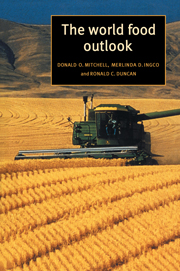Book contents
- Frontmatter
- Contents
- List of figures
- List of tables
- Preface
- List of abbreviations
- 1 The world food problem
- 2 The price of food
- 3 Gains in consumption levels
- 4 World food production increases
- 5 Population growth and food demand
- 6 The quantity and quality of the resource base
- 7 Raising yields
- 8 Changing consumption patterns
- 9 Simulating the future world food situation
- 10 The world can feed twice as many in twenty years
- 11 A robust prediction?
- 12 Africa presents a special challenge at the turn of the century
- Appendix The World Grains Model
- References
- Index
2 - The price of food
Published online by Cambridge University Press: 06 November 2009
- Frontmatter
- Contents
- List of figures
- List of tables
- Preface
- List of abbreviations
- 1 The world food problem
- 2 The price of food
- 3 Gains in consumption levels
- 4 World food production increases
- 5 Population growth and food demand
- 6 The quantity and quality of the resource base
- 7 Raising yields
- 8 Changing consumption patterns
- 9 Simulating the future world food situation
- 10 The world can feed twice as many in twenty years
- 11 A robust prediction?
- 12 Africa presents a special challenge at the turn of the century
- Appendix The World Grains Model
- References
- Index
Summary
The price of food is one of the most important measures of the world food situation since it reflects the overall demand/supply balance. If the price of food rises faster than prices of other goods, it is more expensive for consumers to purchase. An index of food prices relative to income levels is also an important measure of the cost of food. If per capita incomes rise faster than food prices, a declining proportion of income is spent on food (as the income elasticity of demand for food is less than 1).
Food is the largest single expense for most in developing economies where it often accounts for more than one-half of total expenditure. In sub-Saharan Africa up to two-thirds of total personal consumption expenditure is dedicated to food. Even in developing countries which have sustained rapid economic growth in recent years food still accounts for about one-half of total personal consumption expenditure (figure 2.1). In Mexico, about 37 per cent of total personal consumption expenditure is on food and in Thailand the share is 31 per cent.
The share of food in total personal consumption expenditure declines quickly as incomes rise. Hong Kong and Singapore spend less than 20 per cent on food – much the same as many Western European economies. Among industrial economies, expenditure on food for consumption at home ranges from a low of 7.8 per cent in the United States to a high of 20.2 per cent in Japan. The higher proportion of income spent on food in Japan is due in part to the restrictive import policies which maintain prices at higher levels.
- Type
- Chapter
- Information
- The World Food Outlook , pp. 17 - 22Publisher: Cambridge University PressPrint publication year: 1997



